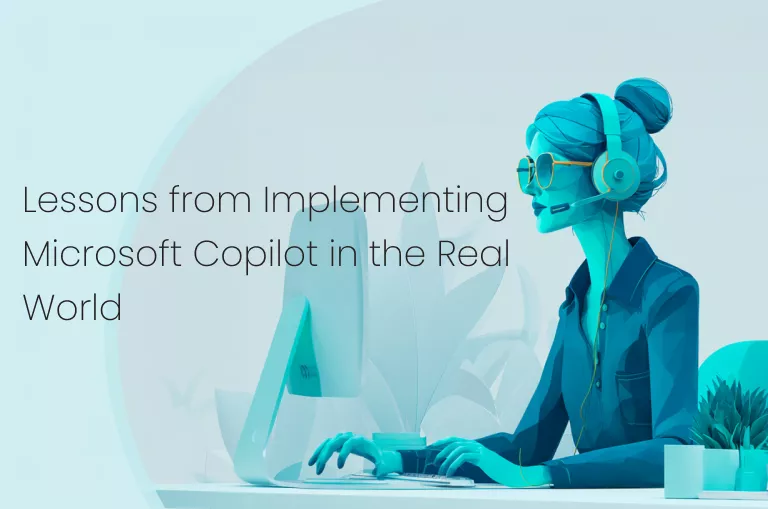From Proof of Concept to Everyday AI: Lessons from Implementing Microsoft Copilot in the Real World
Artificial intelligence has quickly moved from theoretical promise to practical application, and nowhere is that more visible than in Microsoft’s Copilot. For many organisations, the question is no longer if they should adopt AI but how to do it in a way that drives real business impact.
As solution architects working hands-on with Copilot deployments for clients, we’ve seen firsthand how this technology is reshaping workflows, accelerating decision-making, and unlocking value in unexpected ways. This article distils those lessons into practical insights for anyone considering bringing Copilot into their organisation.
Why Copilot Matters Now
The partnership between Microsoft and OpenAI has placed Copilot at the forefront of enterprise AI. By embedding GPT-4 and GPT-5 into Microsoft 365, Dynamics 365, and other services, Copilot is far more than a chatbot. It’s an operational engine that understands context, automates tasks, and connects seamlessly with core business systems.
Competitors have struggled to match this level of integration, and that matters. Copilot doesn’t sit on top of your workflows - it becomes part of them. This is particularly valuable for businesses already invested in the Microsoft ecosystem, as it means AI can be deployed quickly without reinventing existing processes.
The bottom line: Copilot isn’t a futuristic concept waiting to mature. It’s a ready-to-use solution already delivering measurable results in organisations of every size.
Beyond Chat: Copilot as a Business Engine
Most people’s first encounter with AI is through conversational tools, but Copilot’s capabilities extend far beyond generating text. Its real power lies in connecting with your data and acting on it.
Unified Data, Unified Action
At the heart of this is the Microsoft Graph API, which aggregates data from across the Microsoft ecosystem - including SharePoint, Dynamics 365, Teams, Azure Active Directory, and more - into a single, secure access layer. This allows Copilot to:
-
Retrieve complex data such as organisational structures or customer histories.
-
Execute workflows, like creating support cases or searching product databases.
-
Trigger downstream automation, for example, sending targeted follow-up emails.
This integration transforms Copilot from a passive responder into an active participant in business operations. Instead of asking “What is our top product this month?”, you can say “Send me a list of top-selling products and draft an email campaign around them.” Copilot will not only find the answer but also carry out the following steps.
Small Tools, Big Impact: Building Agents and Automations
One of the most transformative features of Copilot is its agent-based approach. Rather than relying on one large AI model to do everything, Copilot allows you to build small, purpose-built agents for specific tasks. These agents can even interact with one another, creating complex workflows from simple components.

How to Scale Automation Effectively
-
Start small: Automate one repetitive process, such as data entry or lead qualification.
-
Iterate: Gather feedback and refine the agent’s responses and actions.
-
Expand: Add complementary agents that handle related tasks.
-
Integrate: Connect agents into a broader automation layer that supports end-to-end processes.
Even low-volume tasks can now be worth automating because the barrier to entry is so low. What once required dedicated development can now be built in a day by a business analyst with minimal coding experience.
The Human Skill That Makes AI Work: Prompt Mindset
The effectiveness of any AI tool depends heavily on how it’s used, and Copilot is no exception. One of the most overlooked success factors in implementation is developing a prompt mindset.
This involves treating prompts not as casual queries but as structured instructions. The more specific and contextual your prompt, the more valuable the output. It also means including “exit conditions” - telling Copilot what to do if the answer isn’t available - and regularly validating its responses to refine future prompts.
Practical prompt strategies include:
-
Breaking complex tasks into smaller, sequential prompts.
-
Using examples and context from past queries to guide the model.
-
Adding validation checks (“If you’re unsure, respond with X instead.”).
Like search engine optimisation in its early days, prompt engineering is becoming a core skill. Teams that master it consistently achieve far better outcomes from their AI tools.

Real Lessons from Projects: Knowledge, Documentation, and Data
In our client projects, one of the most significant factors affecting Copilot performance has been data quality. AI systems are only as good as the information they have access to. If documentation is incomplete, scattered, or locked in inaccessible formats, results will suffer.
Lessons from the Field
-
Structure matters: Converting diagrams and visuals into markup language dramatically improves Copilot’s ability to understand and use them.
-
Identify gaps: When Copilot can’t answer a question, it often reveals missing or unclear documentation.
-
Create a feedback loop: Use user feedback (like thumbs up/down) to prioritise documentation updates.
-
Continuous improvement: Treat Copilot implementation as an evolving system, not a one-off project.
These lessons underscore a fundamental truth: AI projects are as much about information architecture as they are about algorithms.
The Human + AI Equation: Changing Roles, Not Replacing People
One of the most common concerns we hear is that AI will replace human workers. In reality, it changes their roles rather than eliminates them. Copilot automates repetitive, low-value tasks, freeing people to focus on strategic, creative, or empathetic work.
For example, customer support agents can train Copilot to handle routine queries, then focus on complex or emotionally charged cases that require a human touch. Subject matter experts can encode their knowledge into prompts, amplifying their expertise across the organisation.
| Before Copilot | After Copilot |
|---|---|
| Manually answering repetitive queries | Supervising and improving AI responses |
| Searching for scattered documentation | Designing structured knowledge for AI |
| Completing data-entry tasks | Building and maintaining automation agents |
This evolution benefits both businesses and employees. Staff spend less time on repetitive work, while organisations get more consistent and scalable results.
Secure, Context-Aware AI: Why Copilot is the Safer Choice
Security is another major driver for adopting Copilot. Many employees already use public AI tools, sometimes sharing sensitive company data in the process. This creates compliance and data protection risks.
Copilot addresses these concerns by operating entirely within Microsoft’s secure environment, where it can use company data safely and responsibly. It can even adapt responses based on stored client preferences or communication history, making outputs more accurate and context-aware.
However, this requires proper data integration. Without structured and connected data sources, even the most advanced AI will struggle to deliver meaningful results.
Getting Started: Strategic Advice for Leaders
Implementing Copilot doesn’t have to be overwhelming. Successful projects typically follow a structured approach:
-
Set clear objectives: Define what success looks like and how it will be measured.
-
Start small: Begin with one or two high-impact use cases.
-
Build internal champions: Appoint team members to own prompt development and feedback loops.
-
Invest in training: Equip staff with prompt-engineering skills and AI literacy.
-
Iterate and evolve: Treat Copilot as a living system that improves over time.
Following these steps ensures early wins while laying the foundation for deeper, more strategic AI adoption.
Key Takeaways
-
Copilot goes far beyond chat - it connects with your systems, acts on data, and automates real business processes.
-
Data quality, documentation, and continuous improvement are essential for success.
-
A prompt mindset is the difference between average and exceptional results.
-
Roles will evolve, not disappear, as AI handles repetitive tasks and humans focus on higher-value work.
-
Secure integration and structured data give Copilot a significant advantage over public AI tools.
FAQ
Is Copilot difficult to implement?
Not at all. Starting with small, focused use cases makes adoption straightforward and helps teams see results quickly.
Will Copilot replace human jobs?
It changes them. Routine tasks are automated, but new roles emerge around supervision, optimisation, and strategic design.
Can Copilot integrate with non-Microsoft tools?
Yes. While performance is strongest within the Microsoft ecosystem, APIs and connectors allow integration with many third-party systems.
How secure is Copilot compared to public AI platforms?
Copilot operates inside Microsoft’s enterprise-grade environment, ensuring compliance, privacy, and governance standards are met.
Copilot isn’t just changing how companies use Microsoft tools - it’s transforming how teams work, collaborate, and innovate. By starting small, focusing on data quality, and continuously improving, businesses can turn this technology into a competitive advantage that grows more powerful over time.
Ready to see what Copilot could do for your organisation? Talk to ARP Ideas about building your first AI-powered solution today.


